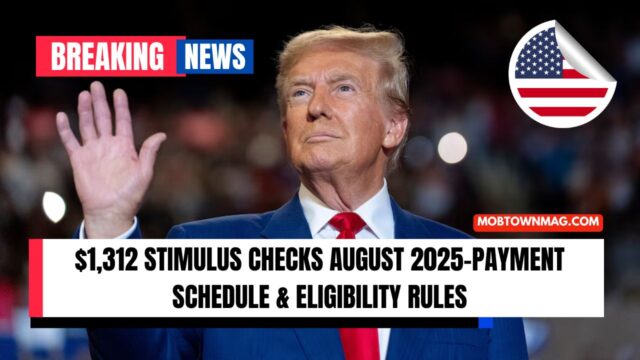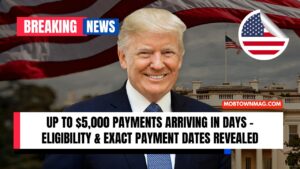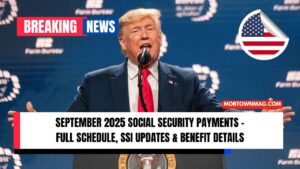With inflation, rising grocery bills, high rent, and fuel prices, many Americans are still struggling to manage their daily expenses in 2025.
To provide financial relief, the government has announced a new $1,312 stimulus check that will be rolled out in August 2025.
These payments are designed to support seniors, veterans, disabled individuals, and low-to-middle-income families who are finding it difficult to keep up with living costs.
This guide explains what the payment is, who qualifies, the exact schedule, and how to claim it. Let’s break everything down in simple terms.
What Are the $1,312 Stimulus Checks?
The $1,312 stimulus check is a one-time federal relief payment being sent to eligible Americans in August 2025.
Unlike the emergency checks issued during the COVID-19 pandemic, this payment is specifically targeted to combat inflation and support families on fixed or limited incomes.
The goal is to help people cover essentials like groceries, rent, medical bills, utilities, and transportation costs. At the same time, it gives a boost to local economies as recipients spend their checks in community stores and businesses.
Why the Stimulus Matters in 2025
The year 2025 has brought continued economic pressures, including:
- High grocery prices that impact families daily.
- Rising healthcare costs, especially for seniors.
- Expensive fuel and utilities, leaving households with less disposable income.
For many, the $1,312 stimulus check could mean:
- Paying overdue bills or reducing debt.
- Covering school supplies and other back-to-school expenses in August.
- Helping seniors afford prescriptions and healthcare.
- Giving families a chance to catch up financially.
In short, it’s more than just money—it’s a temporary safety net for millions of households.
Who Qualifies for the $1,312 Stimulus Check?
Eligibility is strictly defined to ensure the payments reach those most in need. Here are the main rules:
- Social Security Retirees – Anyone already receiving Social Security retirement benefits will automatically qualify.
- SSI/SSDI Recipients – People on Supplemental Security Income (SSI) or Social Security Disability Insurance (SSDI) are included.
- Veterans – Individuals receiving VA benefits will receive the payment through the VA system.
- Low-to-Middle-Income Earners –
- Single filers earning up to $75,000 qualify.
- Married couples filing jointly qualify up to $150,000.
- The payment amount phases out above these limits.
- Tax Filers – You must have filed a 2024 tax return or used the IRS non-filer tool.
Who is excluded?
- Dependents claimed on another person’s tax return.
- High-income earners above the phase-out limits.
Payment Schedule for August 2025
The distribution will happen in three waves, based on eligibility groups and payment methods.
| Date Range (August 2025) | Group Receiving Payment |
|---|---|
| August 5 – 9 | Direct deposits for eligible taxpayers |
| August 12 – 16 | Social Security, SSI, SSDI, and VA recipients (direct deposit) |
| August 19 – 23 | Paper checks and prepaid debit card recipients |
- Direct deposits arrive first and fastest.
- Paper checks may take longer, depending on postal delays.
- All payments are expected to be completed by August 23, 2025.
How to Claim the $1,312 Stimulus Check
Most people don’t need to apply—the payment will be issued automatically if your details are already on file with the IRS, SSA, or VA. However, to avoid delays:
- Update Your Bank Info: Make sure your direct deposit details are up to date with the IRS or Social Security.
- File Your Taxes: If you haven’t filed a 2024 tax return, you should do so immediately.
- Use IRS Non-Filer Tool: For low-income individuals who didn’t file taxes, this is the easiest way to register.
- Track Payments: Use the IRS “Get My Payment” portal to check your status.
If your payment doesn’t arrive by late August, you can contact the IRS or SSA directly for assistance.
Key Details of the $1,312 Stimulus
Here’s a quick summary of the most important facts:
| Feature | Details |
|---|---|
| Payment Amount | $1,312 (one-time) |
| Purpose | Inflation relief and essential expenses |
| Eligible Groups | Social Security, SSI, SSDI, VA, low-to-middle-income earners |
| Income Limits | $75,000 single / $150,000 joint |
| Tax Status | Non-taxable; won’t affect SNAP, Medicaid, or other benefits |
| Distribution | Direct deposit, paper check, or debit card |
| Tracking | IRS “Get My Payment” portal |
Smart Ways to Use Your $1,312
While everyone’s situation is different, here are some practical ways to make the most of your payment:
- Cover Necessities – Pay for groceries, rent, or utility bills.
- Pay Down Debt – Reduce balances on high-interest credit cards.
- Save for Emergencies – Keep a portion aside for unexpected medical or household expenses.
- Invest in the Future – Buy school supplies, repair your home, or start an emergency savings fund.
Using the money wisely can give you both short-term relief and long-term stability.
Protect Yourself from Scams
Unfortunately, stimulus payments often attract scammers. Stay safe by remembering:
- The IRS never asks for personal information via phone, text, or email.
- Only use official websites like irs.gov or ssa.gov.
- If you get a suspicious message, report it immediately to the authorities.
The $1,312 stimulus checks in August 2025 are a much-needed financial boost for millions of Americans. Seniors, veterans, and families struggling with rising living costs can breathe a little easier knowing this relief is on its way.
By checking eligibility, keeping your information up to date, and spending the money wisely, you can make the most of this payment.
Stay alert for scams, monitor your payment status carefully, and plan ahead to use this check as a tool for stability.
For many households, this check is more than just a payment—it’s a lifeline to help manage inflation and secure a stronger financial future.
FAQs
Do I need to apply for the $1,312 stimulus check?
No. If your details are already with the IRS, SSA, or VA, the payment will be automatic.
Is the $1,312 stimulus check taxable?
No. It is not considered taxable income and won’t affect eligibility for SNAP, Medicaid, or other federal benefits.
What if my check doesn’t arrive in August 2025?
You can use the IRS “Get My Payment” tool or call the IRS/SSA for updates. Payments should be complete by August 23, 2025.




